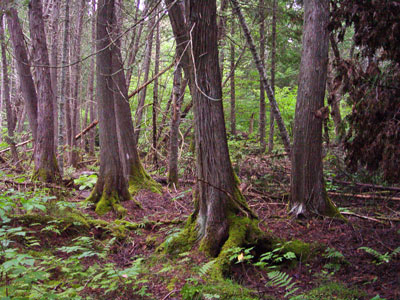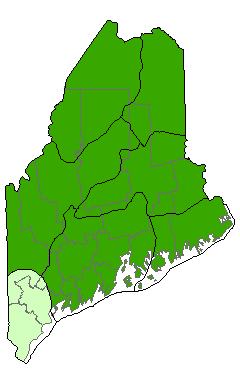DACF Home → Bureaus & Programs → Maine Natural Areas Program → Communities, Plants, and Animals → Natural Community Fact Sheets → Evergreen Seepage Forest
Printer Friendly Fact Sheet - 770 KB pdf (Get a free copy of Adobe Acrobat Reader)
Evergreen Seepage Forest
Scientific Name: Cedar - Spruce Seepage Forest; State Rank: S4

- Community Description
- Soil and Site Characteristics
- Diagnostics
- Similar Types
- Conservation, Wildlife and Management Considerations
- Distribution
- Characteristic Plants
- Associated Rare Plants
- Associated Rare Animals
- Examples on Conservation Lands You Can Visit
Community Description: Northern white cedar and other conifers form a moderate to dense canopy cover (70-95%), allowing only patchy light to penetrate to the forest floor. Northern white cedar is the dominant tree, though red spruce, white spruce, or black spruce may be co-dominant on some sites. Balsam fir, red maple, or yellow birch may be present but not dominant. Shrubs and dwarf shrubs are typically sparse but may be more abundant in canopy gaps caused by harvesting or natural disturbance. The herb layer may be extensive, typically >50% cover, and comprised mostly of non-woody species with northern affinities such as bunchberry, twinflower, or creeping snowberry. The forest floor is characterized by a rich growth of mosses; generally, feather-mosses and liverworts are more abundant than peat mosses. Back to top.
Soil and Site Characteristics: The substrate is shallow peat or organic material over mineral soil, generally saturated with cold groundwater. Water may emerge to form rivulets or small spring fed brooks, or it may remain under the thick layer of mosses. These forests are typically found on gentle, saturated slopes with groundwater seepage, often at the base of slopes near drainage outlets. Back to top.
Diagnostics: These closed canopy (>70%) forests are dominated by northern white cedar on mineral soil (may have a thin organic layer on top, but not deep peat). The bryophyte layer is dominated by feather-mosses and leafy liverworts rather than by peat mosses. Groundwater seeps may be visible. Back to top.
Similar Types: Most similar to and often grade into Northern White Cedar Swamps, which occur in saturated, level basins on organic rather than mineral soils with extensive cover of peat mosses. Open Cedar Fens are partially forested peatlands with a patchy canopy of cedar and a substantial cover of heath or other dwarf shrubs (usually >15% cover), on moderate to deep peat soils. Evergreen Seepage Forests with a substantial amount of red spruce could grade into Spruce - Fir Wet Flats, which usually occur on flats. Back to top.
Conservation, Wildlife and Management Considerations: Most known occurrences of this community type in Maine have been harvested in the past, often targeting removal of spruce. Forest management generally does not result in permanent conversion of this type, although questions remain about how to most successfully regenerate cedar. Some high quality examples exist on public and private conservation lands.
Evergreen seepage forests support numerous orchid species, including some that are rare. This community type may be used as nesting habitat by a number of coniferous forest specialist bird species, including black-backed woodpecker, palm warbler, yellow-bellied flycatcher, gray jay, boreal chickadee, Swainson's thrush, and northern waterthrush. Dead trees provide ideal habitat for three-toed woodpecker. Cool, well-oxygenated forested seeps provide habitat for the northern spring salamander. Back to top.
Distribution: Primarily northern in distribution, extending westward and into Canada. Landscape Pattern: Large Patch. Sites tend to be large (hundreds of acres) in northern Maine and smaller in central and southern Maine. Back to top.


Characteristic Plants: These plants are frequently found in this community type. Those with an asterisk are often diagnostic of this community.
- Canopy
- Balsam fir
- Northern white cedar*
- Red spruce*
- Sapling/shrub
- Fly honeysuckle
- Herb
- Bunchberry
- Creeping snowberry
- Dewdrop
- Goldthread
- Northern wood-sorrel
- Oak fern
- Three-seeded sedge
- Twinflower
- Bryoid
- Mountain fern moss
- Sphagnum mosses
- Three-lobed bazzania
- Northern spring salamander
Examples on Conservation Lands You Can Visit
| Example | County |
|---|---|
| Big Reed Pond Preserve | Piscataquis Co. |
| Chamberlain Lake Public Lands | Piscataquis Co. |
| Deboullie Ponds Public Lands | Aroostook Co. |
| North Branch Inlet, Squa Pan Public Lands | Aroostook Co. |
| Pollywog Gorge, Nahmakanta Public Lands | Piscataquis Co. |
| Salmon Brook Lake Bog Public Lands | Aroostook Co. |
| Sunkhaze Meadows National Wildlife Refuge | Penobscot Co. |